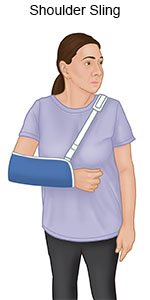Clavicle Fracture in Children
Medically reviewed by Drugs.com. Last updated on Aug 4, 2025.
A clavicle fracture is a crack or break in your child's clavicle (collarbone). A clavicle fracture is a common bone fracture in children.
 |
DISCHARGE INSTRUCTIONS:
Return to the emergency department if:
- Your child's shoulder, arm, hand, or fingers turn blue or white, or feel cold or numb.
- Your child's pain is worse, even after he or she takes pain medicine.
- Your child's sling feels tight, or he or she has increased swelling.
- Your child cannot move his or her fingers.
Call your child's doctor if:
- Your child's sling or wrap comes off or gets damaged.
- You have questions or concerns about your child's condition or care.
Medicines:
Your child may need any of the following:
- Acetaminophen decreases pain and fever. It is available without a doctor's order. Ask how much to give your child and how often to give it. Follow directions. Read the labels of all other medicines your child uses to see if they also contain acetaminophen, or ask your child's doctor or pharmacist. Acetaminophen can cause liver damage if not taken correctly.
- NSAIDs , such as ibuprofen, help decrease swelling, pain, and fever. This medicine is available with or without a doctor's order. NSAIDs can cause stomach bleeding or kidney problems in certain people. If your child takes blood thinner medicine, always ask if NSAIDs are safe for him or her. Always read the medicine label and follow directions. Do not give these medicines to children younger than 6 months without direction from a healthcare provider.
- Do not give aspirin to children younger than 18 years. Your child could develop Reye syndrome if he or she has the flu or a fever and takes aspirin. Reye syndrome can cause life-threatening brain and liver damage. Check your child's medicine labels for aspirin or salicylates.
- Give your child's medicine as directed. Contact your child's healthcare provider if you think the medicine is not working as expected. Tell the provider if your child is allergic to any medicine. Keep a current list of the medicines, vitamins, and herbs your child takes. Include the amounts, and when, how, and why they are taken. Bring the list or the medicines in their containers to follow-up visits. Carry your child's medicine list with you in case of an emergency.
Sling or brace care:
Your child will have a sling or a brace to keep his or her clavicle from moving while it heals. Ask your child's healthcare provider for more information on how to care for the sling or brace, including how to adjust it.
 |
Ice:
Apply ice on your child's clavicle for 15 to 20 minutes every hour or as directed. Use an ice pack, or put crushed ice in a plastic bag. Cover it with a towel. Ice decreases swelling and pain.
Activity:
Encourage your child to rest. Slowly let him or her start to do more each day as the pain decreases. Your child will need to avoid contact sports, such as football, while his or her clavicle heals.
Physical therapy:
Physical therapy may be recommended after your child's clavicle heals. A physical therapist teaches your child exercises to help improve movement and strength, and to decrease pain.
Follow up with your child's doctor in 1 week or as directed:
Your child may need to return for more x-rays to see how well his or her clavicle is healing. Write down your questions so you remember to ask them during your visits.
© Copyright Merative 2025 Information is for End User's use only and may not be sold, redistributed or otherwise used for commercial purposes.
The above information is an educational aid only. It is not intended as medical advice for individual conditions or treatments. Talk to your doctor, nurse or pharmacist before following any medical regimen to see if it is safe and effective for you.
Further information
Always consult your healthcare provider to ensure the information displayed on this page applies to your personal circumstances.
